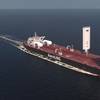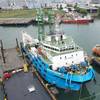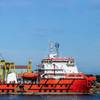NASSCO and BP Hold Naming Ceremony
On Saturday, National Steel and Shipbuilding Company (NASSCO) a wholly owned subsidiary of General Dynamics, joined BP in naming the Alaskan Navigator, the third of four Alaska-class double-hull oil tankers being built for BP Oil Shipping Company. The ship is scheduled to be delivered to BP later this month for service delivering oil from Alaska to West Coast ports, including BP refineries in Los Angeles , Calif. , and Cherry Point , Wash. Caroline Shorten Conn , spouse of Iain Conn, BP Group Executive Officer, is the ship’s sponsor. Mrs. Conn officially named the Alaskan Navigator and broke a ceremonial bottle of champagne across the ship’s hull. Diane Malone, spouse of Bob Malone, Chief Executive of BP Shipping, Ltd., was the sponsor’s Matron of Honor for the ceremony. Bob Malone was the keynote speaker at the event. Dick Vortmann, President of NASSCO, spoke on behalf of the shipyard. The four BP ships are being constructed sequentially in NASSCO’s 1,000-foot graving dock in San Diego . The first ship, the Alaskan Frontier, was delivered to BP Shipping in August 2004. The second ship, the Alaskan Explorer, was delivered in March 2005. Construction on the fourth ship is continuing, with delivery in 2006. The state-of-the-art double-hull ships have a length of 287 meters (941 feet), a beam of 50 meters (164 feet) and a 1.3-million-barrel capacity. The ships’ double hull construction has been designed for a life of 50 years and the deck structure has a life of 35 years, a robust configuration that will perform at peak efficiency for decades in the rigors of the Gulf of Alaska ’s waters. The Alaska-class ships are the most environmentally friendly tankers ever built. The ships use seawater instead of oil to cool and lubricate their propeller shafts, thus eliminating accidental oil leaks from the drive train. Their cargo piping, normally installed on the deck, is inside the cargo tanks, to reduce the risk of small spills. The ships have twin diesel-electric propulsion systems in separate engine rooms, powering two propellers and twin rudders. Diesel-electric propulsion was chosen because it significantly increases reliability and reduces air emissions and maintenance downtime. When completed, the ship will join the largest oil-industry-owned oil and natural gas shipping fleet in the world and will be operated by the Alaska Tanker Company of Portland , Ore. , which operates BP-chartered tankers used in the Alaska North Slope trade and is 25% owned by BP.






